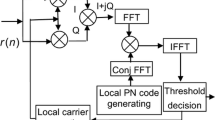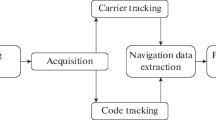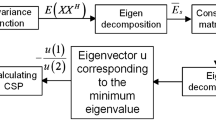Abstract
To acquire Global Navigation Satellite System (GNSS) signal in high-dynamic and long integration applications, the high dimensional search of this detection needs a high computational cost. To reduce the computations of parameters estimation, this paper proposes a low-computation GNSS acquisition method (LGAM) in the high-dynamic environment. Firstly, sparse Doppler frequency (SDF) process is performed for SDF hypotheses, and post-correlation signal model is derived based on SDF structure. Then, double-FFT based detection is proposed based on the post-correlation signal model for parameters estimation. The results demonstrate that due to the reduction of complex multiplications, the computational cost of LGAM is lower than that of the FFT based methods under the moderate signal to noise ratio.






Similar content being viewed by others
Availability of Data and Materials
Data sharing not applicable to this article as no datasets were generated or analyzed during the current study. Consent for publication The manuscript does not contain any individual person’s data in any form (including individual details, images, or videos) and therefore the consent to publish is not applicable to this article.
Abbreviations
- BPSK:
-
Binary phase shift keying
- FAP:
-
False alarm probability
- GNSS:
-
Global Navigation Satellite System
- IT:
-
Integration times
- LGAM:
-
Low-computation GNSS acquisition method
- SDF:
-
Sparse Doppler frequency
- SNR:
-
Signal to noise ratio
- SDHT:
-
Synthesized Doppler frequency hypothesis testing
- MAC:
-
Mean acquisition computation
- DCFT:
-
Discrete chirp-Fourier transform
- FFT:
-
Fast Fourier transform
References
Kong, S. H. (2017). High Sensitivity and Fast Acquisition Signal Processing Techniques for GNSS Receivers: From fundamentals to state-of-the-art GNSS acquisition technologies. IEEE Signal Processing Magazine, 34(5), 59–71.
Cismaru, A., Spens, N., & Akos, D. M. (2023). Future GNSS acquisition strategies and algorithms. In Proceedings of the 36th international technical meeting of the satellite division of the institute of navigation (ION GNSS+ 2023) (pp. 3343–3352).
Xie, F., Sun, R., Kang, G., et al. (2017). A jamming tolerant BeiDou combined B1/B2 vector tracking algorithm for ultra-tightly coupled GNSS/INS systems. Aerospace Science and Technology, 70, 265–276.
Guo, W., Niu, X., Guo, C., et al. (2016). A new FFT acquisition scheme based on partial matched filter in GNSS receivers for harsh environments. Aerospace Science and Technology, 61, 66–72.
Qing, X. Z., Chang, G., Wen, Q. Q., et al. (2020). Parallel Frequency Acquisition Algorithm for BeiDou Software Receiver Based on Coherent Downsampling. Journal of Navigation, 73(2), 433–454.
Zhang, H., Xu, Y., Luo, R., et al. (2023). Fast GNSS acquisition algorithm based on SFFT with high noise immunity. China Communications.
Wu, C., & Gao, Y. (2020). Low-computation GNSS signal acquisition method based on a complex signal phase in the presence of sign transitions. IEEE Transactions on Aerospace and Electronic Systems, 56(6), 4177–4191.
Kong, S. H., & Kim, B. (2013). Two-dimensional compressed correlator for fast PN code acquisition. IEEE Transactions on Wireless Communications, 12(11), 5859–5867.
Ju, Z., Chen, L., & Yan, J. (2023). Acquisition of weak BDS signal in the lunar environment. Remote Sensing, 15(9), 2445.
Kong, S. H. (2015). SDHT for fast detection of weak GNSS signals. IEEE Journal on Selected Areas in Communications, 33(11), 2366–2378.
Yang, C., Nguyen, T., Blasch, E., et al. (2008). Post-correlation semi-coherent integration for high-dynamic and weak GPS signal acquisition. In Position, location & navigation symposium, IEEE/ION (pp. 1341–1349). IEEE.
Yu, W., Zheng, B., Watson, R., et al. (2007). differential combining for acquiring weak GPS signals. Signal Processing, 87(5), 824–840.
Li, X., & Guo, W. (2013). Efficient differential coherent accumulation algorithm for weak GPS signal bit synchronization. IEEE Communications Letters, 17(5), 936–939.
Esteves, P., Sahmoudi, M., & Boucheret, M. L. (2016). Sensitivity characterization of differential detectors for acquisition of weak GNSS signals. IEEE Transactions on Aerospace and Electronic Systems, 52(1), 20–37.
Wu, C., Xu, L., Zhang, H., et al. (2017). An improved acquisition method for GNSS in high dynamic environments: Differential acquisition based on compressed sensing theory. Navigation, 64, 23–34.
Luo, Y., Zhang, L., & Hang, R. (2018). An acquisition algorithm based on FRFT for weak GNSS signals in a dynamic environment. IEEE Communications Letters, PP(99), 1.
Luo, Y., Hsu, L. T., & El-Sheimy, N. (2023). A baseband MLE for snapshot GNSS receiver using super-long-coherent correlation in a fractional Fourier domain. NAVIGATION: Journal of the Institute of Navigation, 70(3).
Foucras, M., Julien, O., Macabiau, C., et al. (2016). Probability of detection for GNSS signals with sign transitions. IEEE Transactions on Aerospace and Electronic Systems, 52(3), 1296–1308.
Fan, B., Zhang, K., Qin, Y., et al. (2013). Discrete chirp-Fourier transform-based acquisition algorithm for weak global positioning system L5 signals in high dynamic environments. Radar Sonar and Navigation IET, 7(7), 736–746.
Wu, C., Xu, L. P., Zhang, H., et al. (2015). A block zero-padding method based on DCFT for L1 parameter estimations in weak signal and high dynamic environments. Frontiers of Information Technology and Electronic Engineering, 16(9), 796–804.
Simon, M. K. (2006). Probability distributions involving Gaussian random variables. Springer.
Tang, P., & Wang, S. (2017). A low-complexity algorithm for fast acquisition of weak DSSS signal in high dynamic environment. GPS Solution, 21(7), 1–15.
Acknowledgements
Not applicable.
Funding
This work was supported by Key Laboratory of Cognitive Radio and Information Processing, Ministry of Education (Guilin University of Electronic Technology) No.: CRKL220207, the National Natural Science Foundation of China under Grant 61901154 and Zhejiang Province Science Foundation for Youths under Grant LQ19F010006.
Author information
Authors and Affiliations
Contributions
All authors made contributions in the discussions, analyses, and implementation of the proposed method solution.
Corresponding author
Ethics declarations
Conflict of interest
The authors declare that they have no competing interests.
Additional information
Publisher's Note
Springer Nature remains neutral with regard to jurisdictional claims in published maps and institutional affiliations.
Appendix: Derivation of Doppler Rate Resolution
Appendix: Derivation of Doppler Rate Resolution
Based on (10), \({\boldsymbol{\Delta }}_{\boldsymbol{\alpha }}=\frac{1}{{{\varvec{N}}}_{{\varvec{B}}0}{{\varvec{T}}}_{{\varvec{s}}}}\) represents Doppler rate resolution, and when \(\left|{\boldsymbol{\alpha }}_{{\varvec{k}}}\right|\le \frac{{\boldsymbol{\Delta }}_{\boldsymbol{\alpha }}}{2}\) in (12), the correct unit corresponding to Doppler rate should be detected. In order not to cause too much attenuation of the detected peak,
So
Since \(\left|{\varvec{sin}}{\varvec{c}}\left({\varvec{\pi}}\frac{{{\varvec{N}}}_{{\varvec{B}}}{{\varvec{T}}}_{{\varvec{s}}}}{{{\varvec{N}}}_{{\varvec{B}}0}}{{\varvec{N}}}_{{\varvec{B}}}\right)\right|\ge \left|{\varvec{sin}}{\varvec{c}}\left({\varvec{\pi}}\frac{{{\varvec{N}}}_{{\varvec{B}}}{{\varvec{T}}}_{{\varvec{s}}}}{{{\varvec{N}}}_{{\varvec{B}}0}}{{\varvec{N}}}_{{\varvec{B}}}{{\varvec{N}}}_{{\varvec{S}}{\varvec{B}}}\right)\right|\), (34) can be simplified further as:
So based on Taylor expansion, (35) can be simplified further as:
When \({N}_{B}\)=20,
Rights and permissions
Springer Nature or its licensor (e.g. a society or other partner) holds exclusive rights to this article under a publishing agreement with the author(s) or other rightsholder(s); author self-archiving of the accepted manuscript version of this article is solely governed by the terms of such publishing agreement and applicable law.
About this article
Cite this article
Wu, C. Low-Computation GNSS Acquisition Method for Sparse Doppler Frequency Hypotheses in High-Dynamic Environment. Wireless Pers Commun 135, 1947–1963 (2024). https://doi.org/10.1007/s11277-024-10967-x
Accepted:
Published:
Issue Date:
DOI: https://doi.org/10.1007/s11277-024-10967-x




